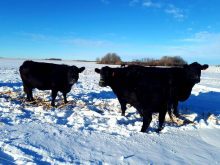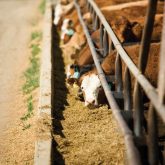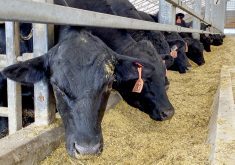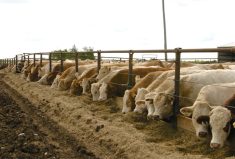No one really seems to know for sure how fababeans will work in silage — but Robyne Bowness has a few educated guesses.
“Fababeans should make a fantastic silage crop,” said Bowness, pulse research scientist with Alberta Agriculture and Rural Development.
“Nutritionally for the animals, fababean is a very good option. It’s high in protein, it has quite a bit of starch, and it has a fair amount of crude fibre. Animals tend to do very, very well on it.”
As fababeans have surged in popularity among crop growers — tripling in acres over the past two years — cattle feeders are considering its merits as a silage crop. Those include being able to fix its own nitrogen, standing up through to harvest, and offering good nutritional value as a feed.
Read Also

Mosquito-borne virus could be devastating to sheep breeding operations
Cache Valley virus, a mosquito-borne disease that infects small ruminants, could be a devastating hit to small operations.
“People like the fact that it grows so tall, and there’s so much biomass to it because it’s so leafy,” said Bowness.
“They’re thinking it would make a really good silage crop simply because of the amount that you get from it.”
But research into using the crop in silage hasn’t been done since the 1980s, when fabas “had their first push into the Prairies.”
“Because they’ve only exploded in the past few years, we haven’t had a chance to go in and do any real amount of research,” said Bowness.
“There’s been a lot of questions about fababeans and silage, but we don’t have a lot of answers.”
The big question is whether cattle feeders will see a good return on feeding fabas in silage.
“The feed costs are pretty high,” said Bowness. “When you’re paying about $15 a bushel for fababean seed, whether or not you’ll get that back economically is one of the questions we don’t know.”
Many farmers are getting around the higher costs by mixing fababeans with oat or barley silage, she said.
“The research showed that fababean alone yielded pretty well and worked well in the silage, but by adding fababean in with the oats and the barley, they ended up with 30 per cent more protein,” said Bowness.
Farmers who are considering using fababeans in silage should plant them early, she said.
“Fababeans do better the earlier you plant them.”
And using a high-tannin variety is a no-no.
“Make sure you’re working with low-tannin varieties because the animals cannot tolerate tannins.”
Bowness suggests trying fababeans on a small scale first to see how they fit in the rotation.
“If you’re interested in growing fababeans for silage, give it a try,” she said. “The animals do very, very well on it, and it will certainly benefit your farm in the long run.”















